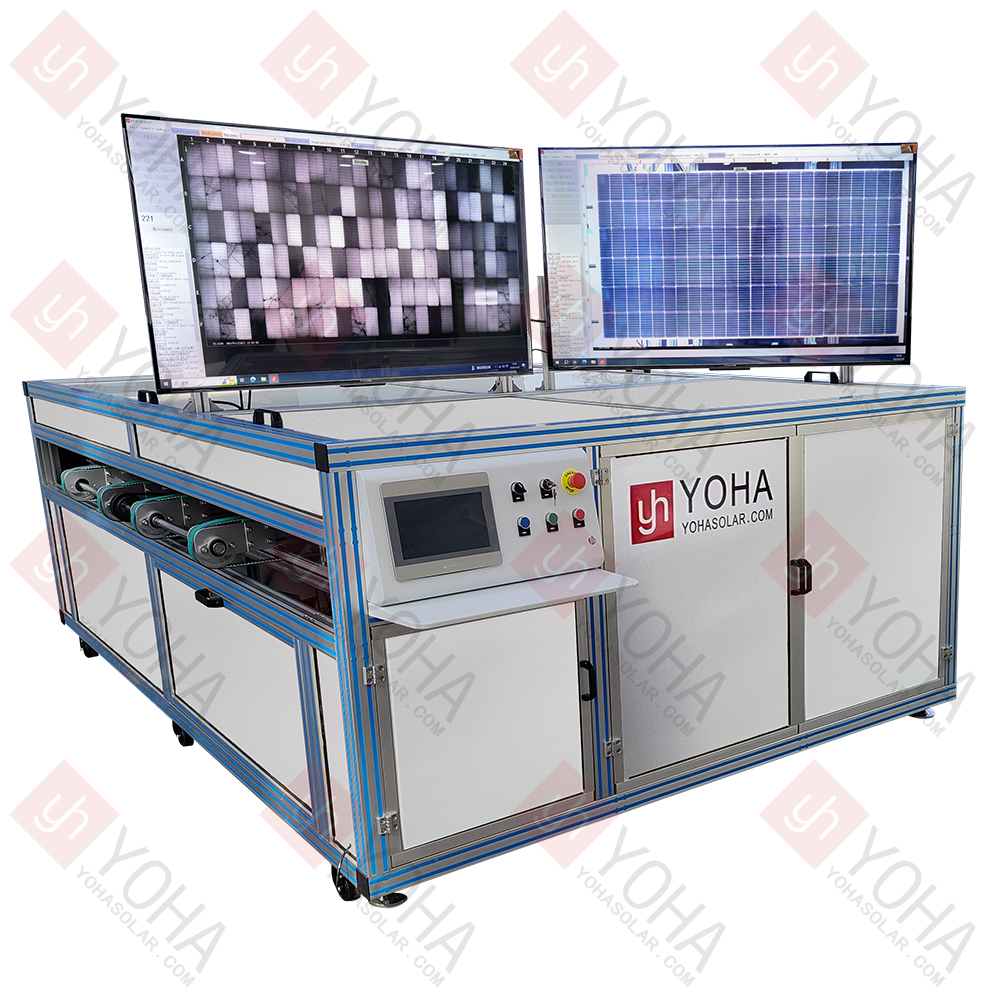Welcome to Wuhan Yoha Solar Technology Co., Ltd!
common problem
Site Map
Language:
 Chinese
Chinese
 English
English
Welcome to Wuhan Yoha Solar Technology Co., Ltd!
common problem
Site Map
Language:
 Chinese
Chinese
 English
English
The Photovoltaic Module EL Appearance Defect Detector is an automated device integrating Electroluminescence (EL) detection and visible light appearance inspection functions. It operates within a dark chamber by applying current to energized modules to stimulate internal luminescence. Using high-sensitivity cameras, it captures EL images while simultaneously acquiring visible light images of the module surface. This enables intelligent identification, localization, and analysis of internal defects such as micro-cracks, fragments, broken fingers, cold solder joints, black cores, and contamination, as well as surface flaws like scratches, chipped edges, dirt, color differences, foreign objects, poor encapsulation, broken cells, and ribbon misalignment. It is a key inspection equipment for achieving comprehensive quality control and reliability assurance throughout the photovoltaic module production process.

Integrates dual functions of Electroluminescence (EL) detection and visible light appearance inspection. It not only accurately identifies internal micro-defects like micro-cracks, fragments, broken fingers, cold solder joints, and black cores but also comprehensively detects surface flaws such as scratches, chipped edges, dirt, color differences, foreign objects, poor encapsulation, and ribbon misalignment, achieving integrated and thorough inspection.
Employs high-precision cameras to capture EL luminescence images of energized modules in a dark chamber environment. Combined with advanced image processing and AI intelligent algorithms, it automatically completes defect identification, localization, classification, and analysis, significantly improving inspection efficiency, accuracy, and reducing reliance on manual labor.
Features millisecond-level image acquisition and processing speeds. Paired with automated production line design, it supports high-speed online inspection, meeting the high-throughput, fast-paced quality control demands of photovoltaic module production lines, ensuring production efficiency and product yield.
Provides clear and intuitive defect reports and visualized data, offering reliable basis for process improvement and quality traceability. It is an indispensable core quality control equipment for ensuring long-term reliability and enhancing product competitiveness of photovoltaic modules.
| Item | Parameter |
|---|---|
| Model | YH-EL8 |
| Applicable Process | Defect Detection for Pre-/Post-lamination Components |
| Testing Specification | Various Monocrystalline & Polycrystalline Cell Modules |
| Camera Type | Professional Industrial Camera |
| Resolution | EL: 60 Megapixels, Appearance: 24 Megapixels |
| Shooting Mode | 8-Camera Area Array Mode |
| Sensitivity | Detectable Crack Width < 0.03mm |
| Loading Method | Automatic Loading/Unloading |
| Detection Method | Online Automatic Detection |
| Effective Testing Area | 2600*1500mm |
| Stabilized Power Supply | 60V/20A |
| Image Acquisition Time | 100~700ms |
| Power Supply | 220V/50HZ |
| Equipment Dimensions | 3095×2220×1665mm |
1. Online Production Line Quality Inspection: Integrated at the end of the photovoltaic module automated production line, it performs high-speed, fully automated EL and appearance defect detection on newly encapsulated components. This is a core link ensuring outgoing product quality and controlling production yield.
2. Laboratory Fine Analysis: Applied in manufacturing enterprise or third-party testing agency laboratories, it enables deeper and more precise defect diagnosis, process effect evaluation, and failure analysis for raw materials (e.g., cells), in-process samples, and finished modules.
3. Power Station O&M and Diagnosis: Using (typically portable or mobile) EL detection equipment, it conducts on-site quality checks, performance evaluations, and fault location during the power station construction phase (checking installation damage) and operation phase (locating faulty components like hot spots, micro-cracks, PID).
4. R&D and Certification Testing: Serves component R&D institutions and certification testing centers. During new product development, new material/process validation, long-term reliability studies (e.g., comparison before and after aging tests), and meeting IEC/UL standard certification requirements, it provides critical defect detection and quality assessment data.
1. Current Safety Warning: The device requires applying DC current to the module during operation. Operators must strictly follow safety procedures, wear insulated equipment, ensure proper device grounding, and absolutely avoid touching electrodes or live module parts during energization to prevent electric shock accidents.
2. Dark Chamber Environment Guarantee: EL detection must be performed in a completely light-proof dark chamber or sealed cavity. Any external light source (including indicator lights, phone screen light) can interfere with EL images, causing false positives or missed detections. Ensure environmental sealing before detection.
3. Module Handling and Placement Specifications: Large modules (especially double-glass modules) are heavy and fragile. Handle and place them onto the detection platform gently and precisely to avoid collisions, drops causing module damage or damage to the platform/probes.
4. Optical System Maintenance: High-sensitivity camera lenses, light sources, and reflectors require regular cleaning and maintenance (using specialized tools and cleaners) to prevent dust, stains, and fingerprints from affecting imaging clarity and detection accuracy. Avoid strong light directly hitting the lens.
5. Software Calibration and Parameter Setting: Set appropriate current-voltage parameters, exposure times, and image processing algorithm thresholds for different module models and power ratings. Perform regular software calibration (e.g., dark field correction, flat field correction) to ensure image quality and the accuracy/consistency of defect determination.
6. Device Compatibility and After-Sales Requirements: Confirm device compatibility with the dimensions, electrical parameters, and connector types of the modules to be tested before use. Strictly follow the manufacturer's manual for installation, operation, and maintenance. Contact professional after-sales personnel for repairs involving critical components or software upgrades to avoid self-disassembly causing equipment failure or warranty invalidation.
TOP
18086473422
MESSAGE
